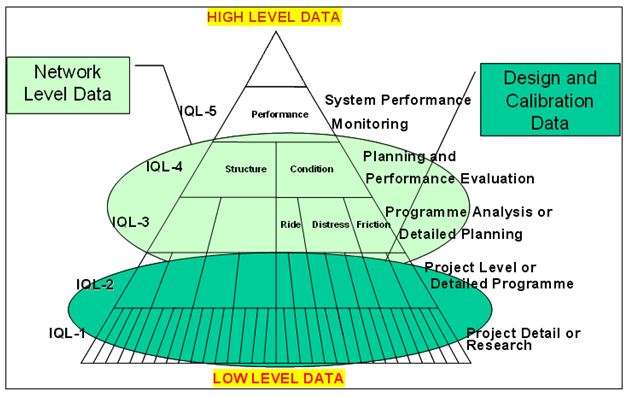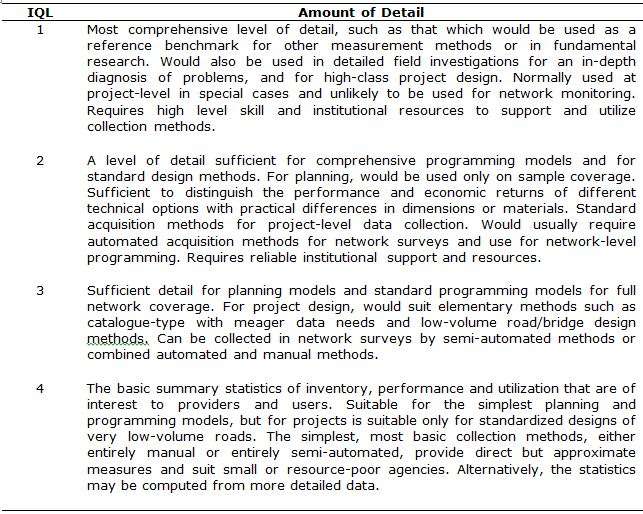Information Quality Level
Information Quality Level (IQL) is a concept developed by the World Bank [1] for structuring road management information into different levels that correlate to the degree of sophistication required for decision making and methods for collecting and processing data. In IQL theory, very detailed data (‘low-level data’) can be condensed or aggregated into progressively simpler forms (higher-level data).
As described in,[2] imagine looking out of an airplane window, just as you are about to land. You recognize the landscape by a bend in the river, or the way a thread-like highway cuts through the landscape. The plane draws nearer, and you can make out your neighborhood, then your home, your car. You have been looking at the same spot throughout the descent, but the “information” available to you became enhanced. While from high above you had enough macro-level information to determine what town you were looking at, you needed a different kind of micro-level information to determine precisely where your car was. You have just experienced first hand the principle behind IQLs.
Five levels of road management IQLs were identified and defined. IQL-1 represents fundamental, research, laboratory, theoretical, or electronic data types, where numerous attributes may be measured or identified. IQL-2 represents a level of detail typical of many engineering analyses for a project-level decision. IQL-3 is a simpler level of detail, typically two or three attributes, which might be used for large production uses like network-level survey or where simpler data collection methods are appropriate. IQL-4 is a summary or a key attribute which has use in planning, senior management reports, or in low effort data collection. IQL-5 represents top level data such as key performance indicators, which typically might combine key attributes from several pieces of information. Still higher levels can be defined as necessary.

At IQL-1, pavement conditions are described by twenty or more attributes. At IQL-2, these would be reduced to 6-10 attributes, one or two for each mode of distress. At IQL-3, the number of attributes is reduced to two to three, namely roughness, surface distress, and texture or skid resistance. At IQL-4, all of the lower-level attributes may be condensed into one attribute, “Pavement Condition” (or “state” or “quality”), which may be measured by class values (good, fair, poor) or by an index (e.g., 0-10). An IQL-5 indicator would combine pavement quality with other measures such as structural adequacy, safety aspects, and traffic congestion—representing a higher order information, such as “road condition”. This is shown in the following table [3]

Three observations that emerge from these definitions are:
- The higher the decision-level, the higher the IQL. Information at IQL-4 or IQL-5 is appropriate for performance indicators and road statistics that are of interest to senior management and the public, because they tend to be, or should be, easily understood without much technical background. At the project-level, however, the appropriate IQL depends much more on the standard of the project and the resources of the agency. For example, IQL-3 is usually sufficient for a rural road or a small local agency. For most agencies and main roads, IQL-2 is typical, but for expressways or high-level, well-funded agencies, IQL-1 may be used in some instances. The criterion to use in selecting the appropriate IQL is to ask, “Is the decision likely to be altered by having more detailed information?”
- Primary data collection at a low-level (detailed) IQL typically costs more and involves more sophisticated equipment than collection of higher IQL data. Thus, the IQL for primary data collection that is appropriate to a given agency and situation depends on the financial and physical resources, skills, cost, speed or productivity, degree of automation, complexity—all summed up in the need for the method to be sustainable for the intended purpose, such as the regular operation of a road management system.
- A higher level IQL often represents an aggregation or transformation of the lower level IQLs. When there is a specific rule or formula for conversion, say, from IQL-2 into IQL-3, then the information is reproducible and reliable. Thus, when the appropriate IQL is chosen, the data can be re-used through transformation to the higher IQL’s as the decision-making moves up the project cycle – this avoids the need for repeating surveys and saves cost.
References
- ↑ Paterson, W. and Scullion, T. (1990) Information Systems for Road Management: Draft Guidelines on System Design and Data Issues. The World Bank, Policy Planning and Research Staff, Infrastructure and Urban Development Department.
- ↑ Bennett, C. and Paterson, W.D.O (2000). A Guide to Calibration and Adaptation of HDM-4. The Highway Development and Management Series, Volume Five. PIARC, Paris.
- ↑ Bennett, C. et al. (2006). Data Collection Technologies for Road Management. Report for the World Bank.